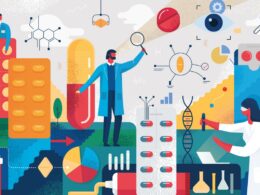This is an excerpt from the publication below, focusing in the area of health care and climate change
What next? 22 emerging technologies to watch in 2022
The Economist
BY THE SCIENCE AND TECHNOLOGY CORRESPONDENTS OF THE ECONOMIST
Nov 8th 2021
The astonishingly rapid development and rollout of coronavirus vaccines has been a reminder of the power of science and technology to change the world.
Although vaccines based on new m RNA technology seemed to have been created almost instantly, they actually drew upon decades of research going back to the 1970s.
As the saying goes in the technology industry, it takes years to create an overnight success.
So what else might be about to burst into prominence? Here are some emerging technologies worth watching in 2022
Quantum computing
An idea that existed only on blackboards in the 1990s has grown into a multi-billion dollar contest between governments, tech giants and startups: harnessing the counter-intuitive properties of quantum physics to build a new kind of computer. For some kinds of mathematics a quantum computer could outperform any non-quantum machine that could ever be built, making quick work of calculations used in cryptography, chemistry and finance.
But when will such machines arrive? One measure of a quantum computer’s capability is its number of qubits. A Chinese team has built a computer with 66 qubits. IBM, an American firm, hopes to hit 433 qubits in 2022 and 1,000 by 2023. But existing machines have a fatal flaw: the delicate quantum states on which they depend last for just a fraction of a second. Fixing that will take years. But if existing machines can be made useful in the meantime, quantum computing could become a commercial reality much sooner than expected.
Vaccines for HIV and malaria
The impressive success of coronavirus vaccines based on messenger RNA (m RNA) heralds a golden era of vaccine development. Moderna is developing an HIV vaccine based on the same m RNA technology used in its highly effective coronavirus vaccine. It entered early-stage clinical trials in 2021 and preliminary results are expected in 2022. BioNTech, joint-developer of the Pfizer-BioNTech coronavirus vaccine, is working on an m RNA vaccine for malaria, with clinical trials expected to start in 2022. Non-m RNA vaccines for HIV and malaria, developed at the University of Oxford, are also showing promise.
3D-printed bone implants
For years, researchers have been developing techniques to create artificial organs using 3 D printing of biological materials. The ultimate goal is to take a few cells from a patient and create fully functional organs for transplantation, thus doing away with long waiting-lists, testing for matches and the risk of rejection.
That goal is still some way off for fleshy organs. But bones are less tricky. Two startups, Particle3 D and ADAM, hope to have 3D-printed bones available for human implantation in 2022. Both firms use calcium-based minerals to print their bones, which are made to measure based on patients’ CT scans. Particle3 D’s trials in pigs and mice found that bone marrow and blood vessels grew into its implants within eight weeks. ADAM says its 3 D-printed implants stimulate natural bone growth and gradually biodegrade, eventually being replaced by the patient’s bone tissue. If all goes well, researchers say 3 D-printed blood vessels and heart valves are next.
Sleep tech
It’s become a craze in Silicon Valley. Not content with maximising their productivity and performance during their waking hours, geeks are now optimising their sleep, too, using an array of technologies. These include rings and headbands that record and track sleep quality, soothing sound machines, devices to heat and cool mattresses, and smart alarm clocks to wake you at the perfect moment. Google launched a sleep-tracking nightstand tablet in 2021, and Amazon is expected to follow suit in 2022. It sounds crazy. But poor sleep is linked with maladies from heart disease to obesity. And what Silicon Valley does today, everyone else often ends up doing tomorrow.
Personalised nutrition
Diets don’t work. Evidence is growing that each person’s metabolism is unique, and food choices should be, too. Enter personalised nutrition: apps that tell you what to eat and when, using machine-learning algorithms, tests of your blood and gut microbiome, data on lifestyle factors such as exercise, and real-time tracking of blood-sugar levels using coin-sized devices attached to the skin. After successful launches in America, personalised-nutrition firms are eyeing other markets in 2022. Some will also seek regulatory approval as treatments for conditions such as diabetes and migraine.
Wearable health trackers
Remote medical consultations have become commonplace. That could transform the prospects for wearable health trackers such as the Fitbit or Apple Watch. They are currently used primarily as fitness trackers, measuring steps taken, running and swimming speeds, heart rates during workouts, and so forth. But the line between consumer and medical uses of such devices is now blurring, say analysts at Gartner, a consultancy.
Smart watches can already measure blood oxygenation, perform ECG s and detect atrial fibrillation. The next version of the Apple Watch, expected in 2022, may include new sensors capable of measuring levels of glucose and alcohol in the blood, along with blood pressure and body temperature. Rockley Photonics, the company supplying the sensor technology, calls its system a “clinic on the wrist”. Regulatory approval for such functions may take a while, but in the meantime doctors, not just users, will be paying more attention to data from wearables.
Brain interfaces
In April 2021 the irrepressible entrepreneur Elon Musk excitedly tweeted that a macaque monkey was “literally playing a video game telepathically using a brain chip”. His company, Neuralink, had implanted two tiny sets of electrodes into the monkey’s brain. Signals from these electrodes, transmitted wirelessly and then decoded by a nearby computer, enabled the monkey to move the on-screen paddle in a game of Pong using thought alone.
In 2022 Neuralink hopes to test its device in humans, to enable people who are paralysed to operate a computer. Another firm, Synchron, has already received approval from American regulators to begin human trials of a similar device. Its “minimally invasive” neural prosthetic is inserted into the brain via blood vessels in the neck. As well as helping paralysed people, Synchron is also looking at other uses, such as diagnosing and treating nervous-system conditions including epilepsy, depression and hypertension.
Heat pumps
Keeping buildings warm in winter accounts for about a quarter of global energy consumption. Most heating relies on burning coal, gas or oil. If the world is to meet its climate-change targets, that will have to change. The most promising alternative is to use heat pumps-essentially, refrigerators that run in reverse.
Instead of pumping heat out of a space to cool it down, a heat pump forces heat in from the outside, warming it up. Because they merely move existing heat around, they can be highly efficient: for every kilowatt of electricity consumed, heat pumps can deliver 3k W of heat, making them cheaper to run than electric radiators. And running a heat pump backwards cools a home rather than heating it.
Gradient, based in San Francisco, is one of several companies offering a heat pump that can provide both heating and cooling. Its low-profile, saddle-bag shaped products can be mounted in windows, like existing air conditioners, and will go on sale in 2022.
Direct air capture
Carbon dioxide in the atmosphere causes global warming. So why not suck it out using machines? Several startups are pursuing direct air capture ( DAC), a technology that does just that. In 2022 Carbon Engineering, a Canadian firm, will start building the world’s biggest DAC facility in Texas, capable of capturing 1m tonnes of CO 2 per year. ClimeWorks, a Swiss firm, opened a DAC plant in Iceland in 2021, which buries captured CO 2 in mineral form at a rate of 4,000 tonnes a year. Global Thermostat, an American firm, has two pilot plants. DAC could be vital in the fight against climate change. The race is on to get costs down and scale the technology up.
VR workouts
Most people do not do enough exercise. Many would like to, but lack motivation. Virtual reality ( VR) headsets let people play games and burn calories in the process, as they punch or slice oncoming shapes, or squat and shimmy to dodge obstacles. VR workouts became more popular during the pandemic as lockdowns closed gyms and a powerful, low-cost headset, the Oculus Quest 2, was released. An improved model and new fitness features are coming in 2022. And Supernatural, a highly regarded VR workout app available only in North America, may be released in Europe. Could the killer app for virtual reality be physical fitness?
Delivery drones
They are taking longer than expected to get off the ground. But new rules, which came into effect in 2021, will help drone deliveries gain altitude in 2022. Manna, an Irish startup which has been delivering books, meals and medicine in County Galway, plans to expand its service in Ireland and into Britain. Wing, a sister company of Google, has been doing test deliveries in America, Australia and Finland and will expand its mall-to-home delivery service, launched in late 2021. Dronamics, a Bulgarian startup, will start using winged drones to shuttle cargo between 39 European airports. The question is: will the pace of drone deliveries pick up-or drop off?
By the Science and technology correspondents of The Economist ■
This article appeared in the What next? section of the print edition of The World Ahead 2022 under the headline “What next?”
Originally published at https://www.economist.com on November 8, 2021.












